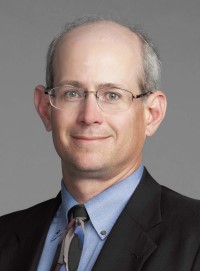Designing and Testing Novel Solutions To Make Labor and Delivery Safer for Moms and Newborns
Louis P. Halamek, M.D.
Neonatologist
Stanford Medicine Children’s Health – Lucile Packard Children’s Hospital

“AHRQ is a unique funding agency, one that is incredibly valuable to investigators like me, who seek to address the challenging problems that we encounter every day in delivering care to our patients. The PSLL [Patient Safety Learning Laboratory] mechanism is especially helpful in that it allows investigators to truly explore an area of interest.”
Childbirth comes with high risks for mothers and newborns in the United States, which has the highest rate of maternal and newborn deaths among developed nations. Louis P. Halamek, M.D., a neonatologist who works in a Level IV (most critically ill) neonatal intensive care unit at the Stanford Medicine Children’s Health – Lucile Packard Children’s Hospital, knows firsthand that we have much more work to do to ensure that all moms and babies receive safe, equitable, and high-quality care. For more than 30 years, he has worked to advance perinatal care, with a focus on events in labor and delivery and the neonatal intensive care unit. AHRQ funding is helping Dr. Halamek design and test innovative solutions in an effort to lower the rates of maternal and infant deaths and harms.
Dr. Halamek, who also is a professor in both the Department of Pediatrics and the Department of Gynecology and Obstetrics at Stanford Medicine, was awarded a 5-year AHRQ-funded Patient Safety Learning Laboratory grant in 2014. The Optimizing Safety of Mother and Neonate in a Mixed-Methods Learning Laboratory brought together a team of researchers and practitioners of diverse disciplines—including neontologists, engineers, and design specialists—to study, develop, and test innovative designs to improve the quality and safety of maternal-newborn healthcare.
Among the designs the Stanford team developed and tested was a newborn data display that shows key information, such as heart rate and minute-to-minute changes in blood oxygen levels, to support decision making. They also designed a delayed cord-clamping cart (DCCC) to provide a stable platform for the newborn while still connected to the umbilical cord. “Delaying umbilical cord clamping for 1 minute or longer following a newborn’s birth is recommended for preterm and full-term newborns,” explained Dr. Halamek. Delayed cutting of the umbilical cord has been shown to decrease rates of iron deficiency anemia, intraventricular hemorrhage (bleeding inside or around the brain), and blood transfusion. The small, sterile mobile cart is positioned next to the operating room table, allowing the patient to be placed onto it immediately after birth. A patent for the DCCC currently is pending.
In 2022, with a continued focus on making labor and delivery safer, Dr. Halamek, who also is Director of Neonatal Resuscitation at Lucile Packard Children’s Hospital, was awarded another AHRQ-funded Patient Safety Learning Laboratory grant. This current Patient Safety Learning Lab, Applying Human Factors Science, Design Thinking, and Systems Engineering to Mitigate Threats to Neonates Undergoing Resuscitation and Stabilization, aims to improve three specific aspects of neonatal resuscitation: the design of the physical workspace; decision making during this procedure; and human-technology interaction.
Approximately 400,000 newborns need some assistance to begin breathing at birth. “Neonatal resuscitation requires accurate decision-making, proficient technical interventions, and flawless teamwork in order to save lives and prevent serious morbidity, all while working under intense time pressure,” according to Dr. Halamek. “The decisions made and interventions performed in those first minutes of life can determine whether the child lives, dies, or survives, potentially with significant lifelong illness.” The project is expected to end September 29, 2026.
Dr. Halamek has been an AHRQ grantee for more than 20 years, receiving his first AHRQ grant in 2001. The goal of that 3-year grant was to find out whether use of his previously developed newborn resuscitation simulation-based medical training program, NeoSim® improved healthcare provider performance and enhanced patient safety in the real delivery room.
According to Dr. Halamek, NeoSim now serves as the basis for the simulation-based training and briefing and debriefing methods used by the American Academy of Pediatrics’ Neonatal Resuscitation Program (NRP). “The NRP sets the standard for neonatal resuscitation in the U.S., and has been used by more than 3 million trainees and 20,000 instructors,” said Dr. Halamek. He credits AHRQ funding with enabling his team to establish and refine this simulation-based approach to training and research.
In addition to his other roles, Dr. Halamek is the founding Director of the Center for Advanced Pediatric and Perinatal Education. He also is a Fellow of the American Academy of Pediatrics.
Principal Investigator: Louis Halamek, M.D.
Institution: Stanford Medicine Children’s Health – Lucile Packard Children’s Hospital
Grantee Since: 2001
Type of Grant: Various
Related AHRQ Resources
- Effective Healthcare Program
- Healthcare Simulation Dictionary
- The Contribution of Diagnostic Errors to Maternal Morbidity and Mortality During and Immediately After Childbirth: State of the Science
- Toolkit for Perinatal Safety
Consistent with its mission, AHRQ provides a broad range of extramural research grants and contracts, research training, conference grants, and intramural research activities. AHRQ is committed to fostering the next generation of health services researchers who can focus on some of the most important challenges facing our Nation's health care system.
To learn more about AHRQ's Research Education and Training Programs, please visit https://www.ahrq.gov/training.



